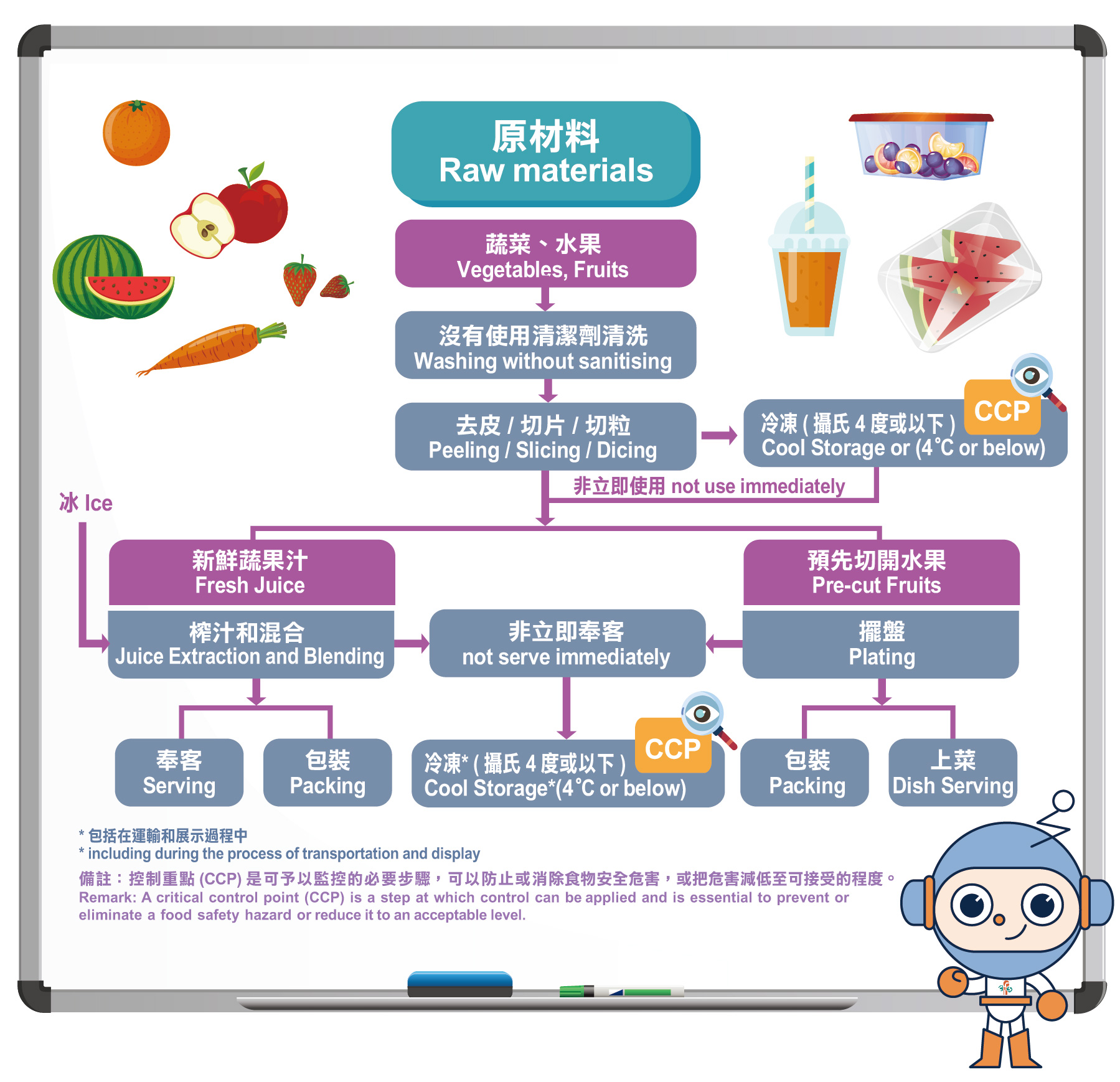
Food Safety Focus (225th Issue, April 2025) – Article 2
Safe Preparation of Pre-Cut Fruits and Fruit Juices
Reported by Arthur YAU, Scientific Officer,
Risk Communication Section, Centre for Food Safety
Pre-cut fruits and fruit juices are widely popular, especially during summer, due to their convenience and refreshing qualities. They provide an accessible way to enjoy the nutritional benefits of fresh produce. However, large-scale food poisoning outbreaks involving cut fruits and juices have been reported from various regions worldwide, with many cases linked to contamination during various stages of production with pathogenic microorganisms. Improper handling of these food products can pose significant risks, leading to foodborne illnesses. This article will discuss the safe preparation and handling of pre-cut fruits and fruit juices in commercial settings, ensuring consumers can enjoy them with confidence.
Understanding the Risks
Pre-cut fresh fruits and juices are considered high-risk foods because they often involve extensive manual handling and are typically consumed without undergoing heat treatment. This creates multiple opportunities for harmful bacteria to survive and exist in the final product if ill-handled during preparation. Key pathogens of concern include Listeria monocytogenes, Salmonella species and Shiga toxin-producing Escherichia coli (STEC) which can pose health risks like diarrhoea, feva and kidney failure in extreme cases. Additionally, mouldy or damaged fruits may contain mycotoxins, specifically patulin. For example, patulin can persist in juices made from damaged apples and can cause nausea, gastrointestinal disturbance and vomiting in humans. By understanding these potential food safety risks and implementing appropriate control measures throughout production, contamination and deterioration can be minimized, ensuring both the safety and quality of these products.

Figure 2. Flow diagram of pre-cut fruits and fresh fruit and vegetable juices production.
Best Practices for Preparing Pre-cut Fruits and Fruit Juices
- Choosing Fresh Produce
When purchasing fruits and vegetable ingredients, always purchase from reliable sources and choose produce that is fresh, undamaged and free from bruises. Inspect fruits carefully upon receiving, as external damage may indicate internal issues. Chilled ingredients should be free from signs of temperature abuse, such as water or fluid stains on the packaging.
- Proper Storage
Handle fresh produce with care to avoid bruising or damage. Store fresh fruits in the refrigerator and keep them away from raw food to prevent cross-contamination and avoid overloading. Store fruits in a cool and dry place, preferably in the refrigerator at a temperature of 4°C or below. Highly perishable items like berries and grapes should be refrigerated immediately. All utensils, including disposable ones, should also be stored in a clean and sanitary manner.
- Washing Fruits
Always wash hands thoroughly with soap and water before handling any food. Before cutting or juicing, remove any damaged or mouldy produce and discard any rotten ones. Wash all fruits thoroughly under running water, ideally in a sink designated solely for this purpose. For firm-skinned fruits like melons, use a clean produce brush to remove surface dirt. Ensure that all all utensils, machines and preparation surfaces are cleaned and sanitised before use.
- Cutting and Preparing
When cutting fruits, use clean knives and cutting boards. Remove any bruised or damaged areas, as these can harbour harmful bacteria. Check the presence of internal mould when cutting the fruits and discard the mouldy ones. Use separate equipment and utensils for handling fresh ready-to-eat produce to minimise the risk of cross-contamination. If preparing fruit juices, ensure that any machinery used, such as juicers or blenders, is also cleaned and sanitised.
- Storing Pre-cut Fruits
After cutting or peeling, store fruits in airtight containers or wrap fruits tightly in plastic wrap before refrigerating them immediately at 4°C or below. Do not leave pre-cut fruits at room temperature for more than two hours. If water or ice is required as an ingredient, use only food grade ice or distilled or boiled water. Discard any leftovers.
- Serving and Consumption
It is best to serve pre-cut fruits or juices immediately after preparation. If the products are not consumed immediately, store them in clean containers with close-fitting cover at 4°C or below and label them with a use-by date. Do not leave pre-cut fruits or juices at above 4°C for more than two hours. Keep the display area clean and inspect the products regularly and dispose of them if they have signs of deterioration.
Conclusion
Pre-cut fruits and fruit juices require extensive manual handling and are often consumed without heat treatment, making strict adherence to safe handling practices critical. Implementing a preventive food safety management system such as the HACCP-based Food Safely Plan to enable identification and control of food safety hazards at every stage of food production. Food businesses should strictly adhere to the established hygiene and safety guidelines when preparing and selling pre-cut fruits and fresh juices. For more information, please visit the CFS webpage for the full Guidelines.

